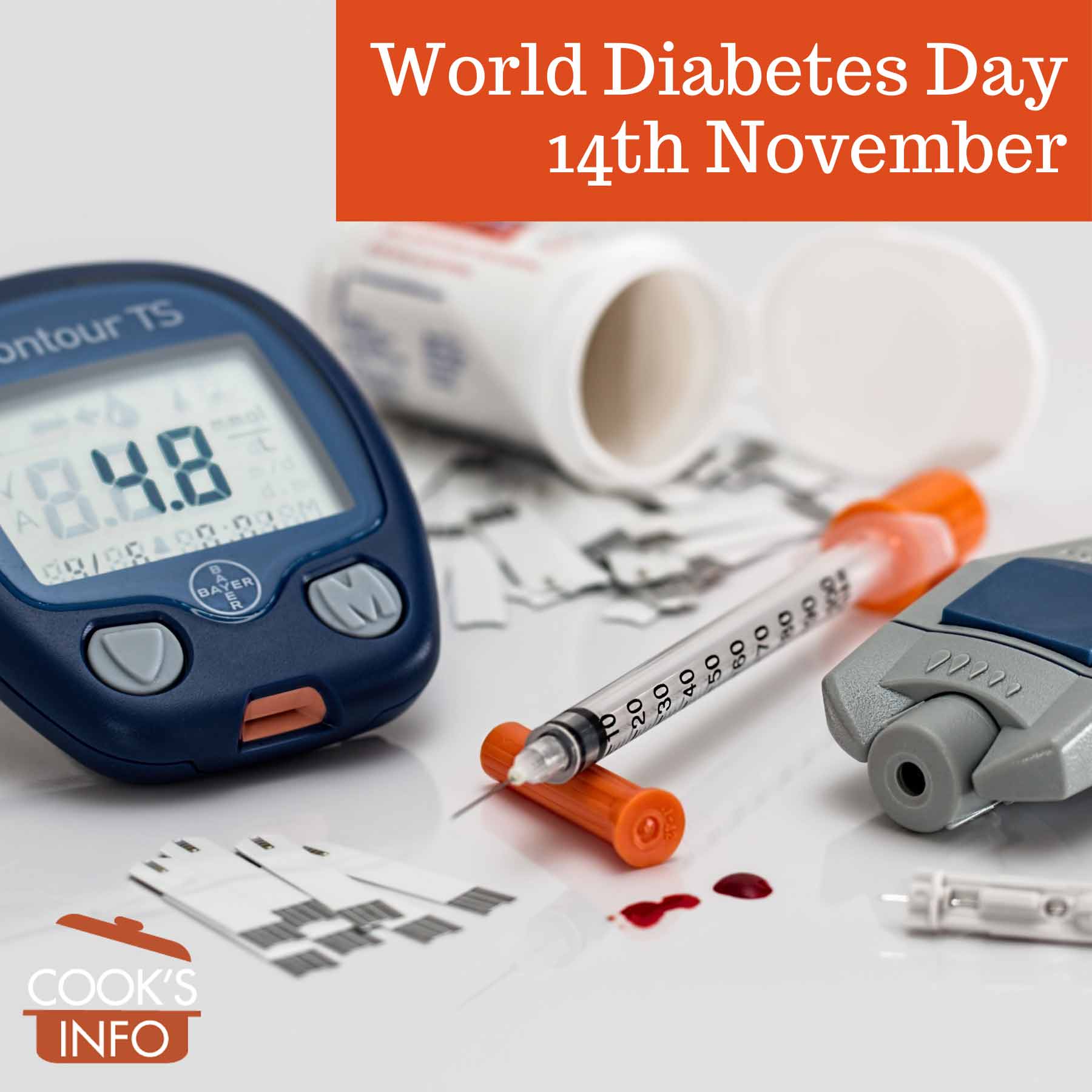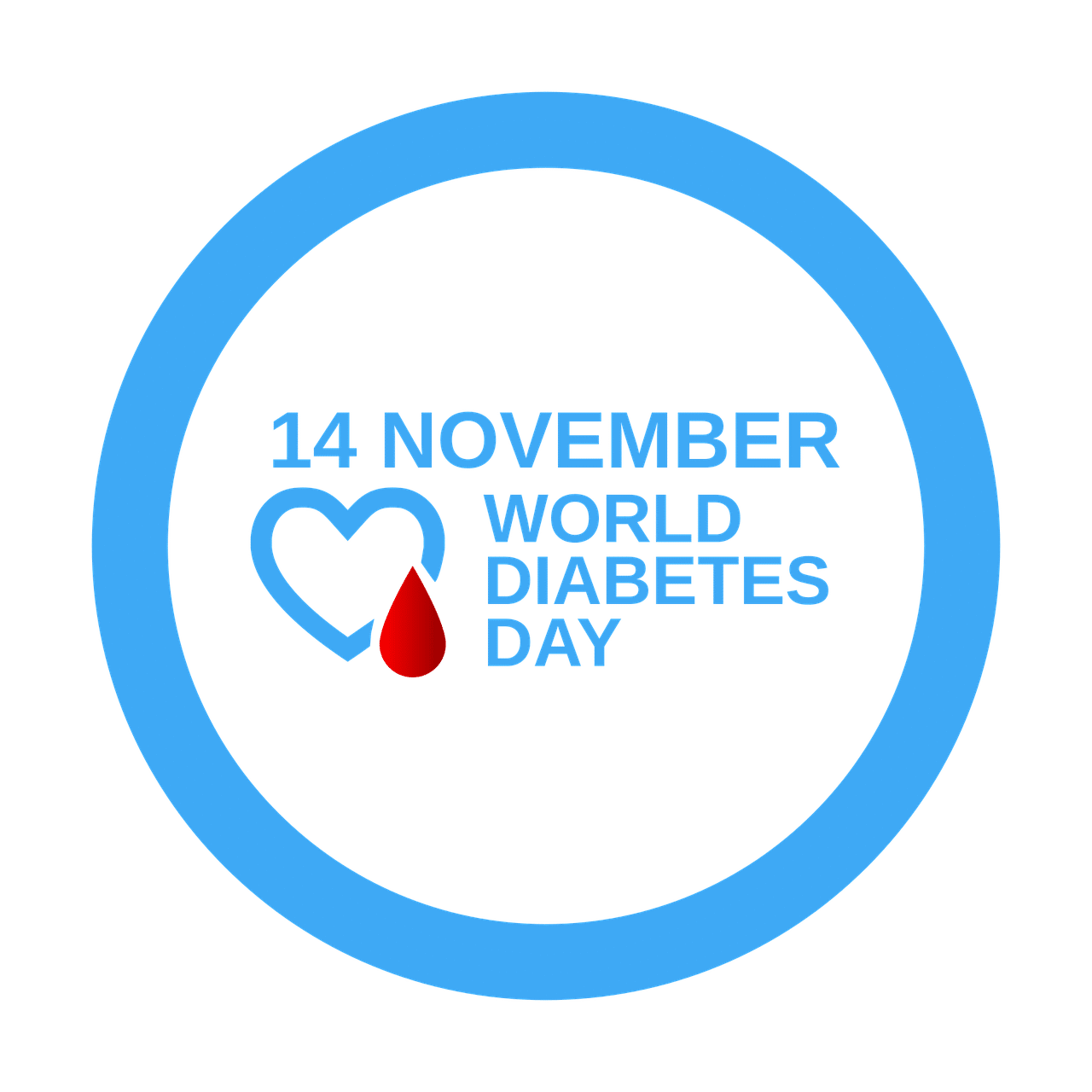
Steve Buissinne / Pixabay.com / 2014 / CC0 1.0
The 14th of November is World Diabetes Day.
There is type 1 and type 2 diabetes.
“More than 95% of people with diabetes have type 2 diabetes. This type of diabetes is largely the result of excess body weight and physical inactivity.” [1]Diabetes Key Facts. World Health Organization. 10 November 2021. Accessed October 2021 at https://www.who.int/news-room/fact-sheets/detail/diabetes
Diet can be one of the key factors in delaying and avoiding type 2 diabetes.
Type 2 diabetes can be delayed or prevented by “a healthy diet, regular physical activity, maintaining a normal body weight and avoiding tobacco use.” [2]Diabetes Key Facts. World Health Organization. 10 November 2021. Accessed October 2021 at https://www.who.int/news-room/fact-sheets/detail/diabetes
Diet can play a key role in preventing pre-diabetes from developing further, or in reversing Type 2 diabetes, with of course the supervision of your physician and ideally the guidance of a registered dietician as well.
No information on this page should be construed as authoritative medical advice: rather, it is just pointers to reputable sources of information from a food perspective.
#WorldDiabetesDay #Diabetes
Website: https://worlddiabetesday.org/
Facebook: https://www.facebook.com/worlddiabetesday/
Twitter: https://twitter.com/WDD
About the campaign
The World Diabetes Day campaign is designed to raise awareness of diabetes advocacy efforts throughout the rest of the year, and to promote coordinated action to tackle diabetes as a global health issue.
The logo for the day was adopted in 2007. The blue circle of the logo signifies the unified response of the global community to diabetes.
Every year, there is a different theme. Sometimes a theme will run for more than one year, as it has from 2021 to 2023.
An overview of the extent of the diabetes public health crisis
The World Health Organization estimates that 422 million people around the world have diabetes. [3](These 2014 numbers are still the most recent numbers as of 2021.) Diabetes Key Facts. World Health Organization. 10 November 2021. Accessed October 2021 at https://www.who.int/news-room/fact-sheets/detail/diabetes
“Every five seconds one person develops diabetes…every 10 seconds one person dies of diabetes…every 30 seconds a limb is lost to diabetes.” [4]World Diabetes Day 14 November. United Nations. Accessed October 2021 at https://www.un.org/en/observances/diabetes-day
- In the United States, “an estimated 30.3 million people of all ages — or 9.4% of the U.S. population — had diabetes in 2017.” [5]What is World Diabetes Day? UC Davis Health. Accessed October 2021 at https://health.ucdavis.edu/livinghealthy/topic/diabetes/world-diabetes-day.html
- In the United Kingdom, there were approximately 4 million people with diagnosed or undiagnosed diabetes or pre-diabetes as of 2015 — 6% of the population. [6] Diabetes Facts and Stats: 2015 – Diabetes UK, published 2015
- In Canada, as of 2021, there are approximately 11 million people currently living with diagnosed diabetes or pre-diabetes as of 2016 — 10% of the population. [7]Diabetes in Canada: Backgrounder. Ottawa: Diabetes Canada; 2020. Page 1.
Activities for today
- Identify sources of diabetes-friendly recipes. Strictly speaking, there’s no such thing as “diabetic diets”: still, many collections of “diabetes-friendly” recipes bring together recipes that just plain make a lot of health sense for everyone!;
- Learn about sugar-free home canning, we can all do with a lot less sugar and carbs snuck into foods we don’t expect it in, and it can be next to impossible to buy;
- Ask your doctor about getting tested – the earlier you can identify pre-diabetes, the better.
Diet myths about diabetes
Myth: Diabetes is caused by eating too much sugar.
Fact: Eating sugar does not directly cause diabetes.
Type 1 diabetes is an autoimmune disease, not caused by what you eat.
As for type 2 diabetes, “Though we know sugar doesn’t directly cause type 2 diabetes, you are more likely to get it if you are overweight. You gain weight when you take in more calories than your body needs, and sugary foods and drinks contain a lot of calories. So you can see if too much sugar is making you put on weight, then you are increasing your risk of getting type 2 diabetes. But type 2 diabetes is complex, and sugar is unlikely to be the only reason the condition develops. We also know that sugar sweetened drinks, like canned soft drinks, are associated with an increased risk of type 2 diabetes, and this is not necessarily linked to their effect on body weight.” — Sugar and Diabetes. Diabetes UK. [8]Sugar and Diabetes. Diabetes UK. Accessed October 2021 at https://www.diabetes.org.uk/guide-to-diabetes/enjoy-food/eating-with-diabetes/food-groups/sugar-and-diabetes
Sugar and diabetics can be a complicated question. For a full discussion, see: Myth Buster: Dishing the Details on Diabetes (University of Rochester Medical Center)
Myth: People living with diabetes should not eat any carbohydrate-containing foods.
Fact: Diabetics still need and can still enjoy carbs
“Contrary to popular thinking, people with diabetes can enjoy moderate amounts of carbohydrates in their diets. The emphasis is on carbohydrate control NOT carbohydrate avoidance. Actually, carbohydrates are the body’s preferred energy source, and roughly half of your daily calorie intake should come from carbohydrate foods.” — Carbohydrates & Blood Sugar Control for People with Diabetes. Cleveland, Ohio: Cleveland Clinic. [9]Carbohydrates & Blood Sugar Control for People with Diabetes. Cleveland, Ohio: Cleveland Clinic. Accessed October 2021 at https://my.clevelandclinic.org/health/articles/11651-carbohydrates–blood-sugar-control-for-people-with-diabetes
For a full discussion, see: Carbohydrates and Blood Sugar (Harvard T.H. Chan School of Public Health.
Myth: People living with diabetes need to follow a special “diabetic” diet.
Fact: There is no such thing as a special, dedicated “diabetic” diet.
Choose healthy foods the same as everyone else should: whole grains instead of refined grains, lots of fresh fruits and non-starchy vegetables, high fibre and high protein foods. Limit sugary beverages, and foods with added sugars. “Sweets do not have to be completely avoided, but are best if limited to small portions.” — Chopra, Monica and Ravneet Dhaliwal. Diabetes Healthy Eating Insight. Toronto, Canada: South Riverdale Community Health Centre. [10]Chopra, Monica and Ravneet Dhaliwal. Diabetes Healthy Eating Insight. Toronto, Canada: South Riverdale Community Health Centre. April 2015 https://www.srchc.ca/wp-content/uploads/2017/06/South-Asian-Cookbook-Diabetes-Healthy-Eating-Insight.pdf
Myth: Diabetes is the result of life or the universe judging you.
Fact: Getting diabetes is not your fault.
It’s not because you alone of all people ate too much sugary food, or you alone were physically lazy. You probably aren’t eating much better or worse, or exercising any more or less, than most others around you. Diabetes is caused by genetics plus environment. [11]Sovdi, Rebecca. Myths and Truths About Diabetes. Presentation: Gathering Wisdom VI, Wednesday, October 23, 2013 . Accessed October 2021 at https://www.fnha.ca/Documents/GWVI_CDM_presentation.pdf
Resources
Resources for World Diabetes Day
- World Diabetes Day at the United Nations
- Resolution on World Diabetes Day adopted by the UN General Assembly
- WHO Global Report on Diabetes
Some diabetes information sources
- Sovdi, Rebecca. Myths and Truths About Diabetes. First Nations Health Authority. Presentation: Gathering Wisdom VI, Wednesday, October 23, 2013.
- Gray A, Threlkeld RJ. Nutritional Recommendations for Individuals with Diabetes. [Updated 2019 Oct 13]. In: Feingold KR, Anawalt B, Boyce A, et al., editors. Endotext [Internet]. South Dartmouth (MA): MDText.com, Inc.; 2000-. Available from: https://www.ncbi.nlm.nih.gov/books/NBK279012/
Diabetes courses
- Living with Diabetes (Open University)
- Online courses on diabetes (almost all of them free) on diabetes taught by various universities
Some diabetes organizations
- Diabetes United States
- Diabetes UK
- Diabetes Canada
- Diabètes Québec
- Diabetes Australia
- Diabetes New Zealand
Food resources for World Diabetes Day
- Chopra, Monica and Ravneet Dhaliwal. Diabetes Healthy Eating Insight. Toronto, Canada: South Riverdale Community Health Centre. April 2015
- Diabetic recipes (BBC Good Food)
- Diabetes Australia recipes
- Diabetes friendly recipes (Splenda)
- Sugar’s role in home canning
- Sugar-free jams and marmalades
- Home canning fruit sugar-free
It is particularly important that people with diabetes (and those preparing food for them) practice safe food handling to prevent foodborne illness.
History
World Diabetes Day day was started in 1991 as a partnership between the International Diabetes Foundation and the World Health Organization.
In 2006, the United Nations made it an official World Day by passing resolution 61/225.
The 14th of November was chosen as it is the birthday of Sir Frederick Banting, the co-discoverer of insulin in 1922. Sadly, revelations about Banting later raised questions about whether he was an anti-semite, but that doesn’t change obviously the usefulness of the product he created along with Charles Best in 1922. [12]Cummings, Brian Earnest. Sir Frederick Banting: The Anti-Semite and Bigot? Halifax, Nova Scotia: Dalhousie Medical Journal. Vol. 30, # 1. Pp 27-29.
Past themes for World Diabetes Day
2023 – Access to Diabetes Care – If Not Now, When
2022 – Access to Diabetes Care – If Not Now, When
2021 – Access to Diabetes Care – If Not Now, When
2020 – The Nurse and Diabetes
2018 – 2019: The Family and Diabetes – diabetes concerns every family
2017 – Women and diabetes – our right to a healthy future
2016 – Eyes on Diabetes
2015 – Healthy Eating
2014 – Go Blue for Breakfast
2013 – Protect our Future: Diabetes Education and Prevention
Sources
What is World Diabetes Day? UC Davis Health. Accessed October 2021 at https://health.ucdavis.edu/livinghealthy/topic/diabetes/world-diabetes-day.html
Latinsky, Michelle (RD). Debunking Diabetes Myths. Accessed October 2021 at https://www.weightwatchers.com/ca/en/article/debunking-diabetes-myths
References
| ↑1 | Diabetes Key Facts. World Health Organization. 10 November 2021. Accessed October 2021 at https://www.who.int/news-room/fact-sheets/detail/diabetes |
|---|---|
| ↑2 | Diabetes Key Facts. World Health Organization. 10 November 2021. Accessed October 2021 at https://www.who.int/news-room/fact-sheets/detail/diabetes |
| ↑3 | (These 2014 numbers are still the most recent numbers as of 2021.) Diabetes Key Facts. World Health Organization. 10 November 2021. Accessed October 2021 at https://www.who.int/news-room/fact-sheets/detail/diabetes |
| ↑4 | World Diabetes Day 14 November. United Nations. Accessed October 2021 at https://www.un.org/en/observances/diabetes-day |
| ↑5 | What is World Diabetes Day? UC Davis Health. Accessed October 2021 at https://health.ucdavis.edu/livinghealthy/topic/diabetes/world-diabetes-day.html |
| ↑6 | Diabetes Facts and Stats: 2015 – Diabetes UK, published 2015 |
| ↑7 | Diabetes in Canada: Backgrounder. Ottawa: Diabetes Canada; 2020. Page 1. |
| ↑8 | Sugar and Diabetes. Diabetes UK. Accessed October 2021 at https://www.diabetes.org.uk/guide-to-diabetes/enjoy-food/eating-with-diabetes/food-groups/sugar-and-diabetes |
| ↑9 | Carbohydrates & Blood Sugar Control for People with Diabetes. Cleveland, Ohio: Cleveland Clinic. Accessed October 2021 at https://my.clevelandclinic.org/health/articles/11651-carbohydrates–blood-sugar-control-for-people-with-diabetes |
| ↑10 | Chopra, Monica and Ravneet Dhaliwal. Diabetes Healthy Eating Insight. Toronto, Canada: South Riverdale Community Health Centre. April 2015 https://www.srchc.ca/wp-content/uploads/2017/06/South-Asian-Cookbook-Diabetes-Healthy-Eating-Insight.pdf |
| ↑11 | Sovdi, Rebecca. Myths and Truths About Diabetes. Presentation: Gathering Wisdom VI, Wednesday, October 23, 2013 . Accessed October 2021 at https://www.fnha.ca/Documents/GWVI_CDM_presentation.pdf |
| ↑12 | Cummings, Brian Earnest. Sir Frederick Banting: The Anti-Semite and Bigot? Halifax, Nova Scotia: Dalhousie Medical Journal. Vol. 30, # 1. Pp 27-29. |


